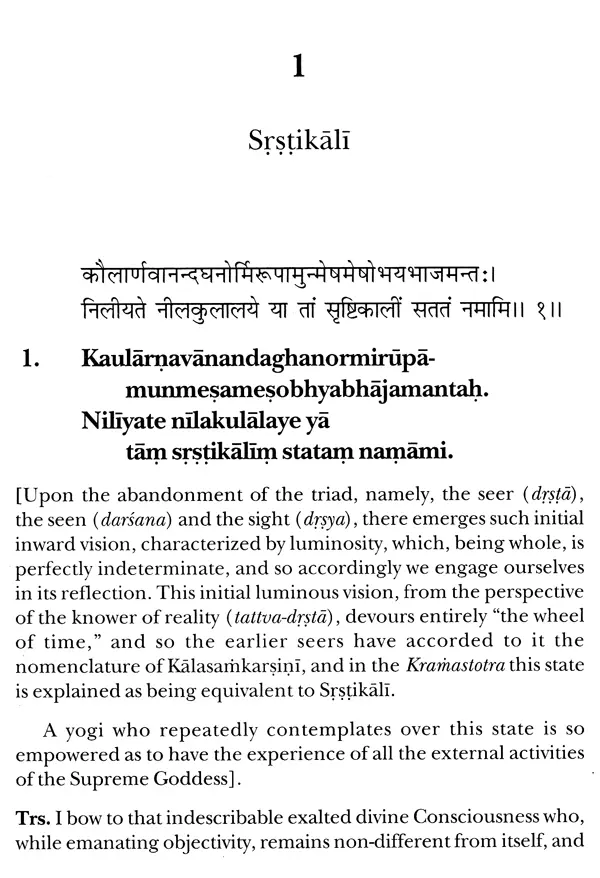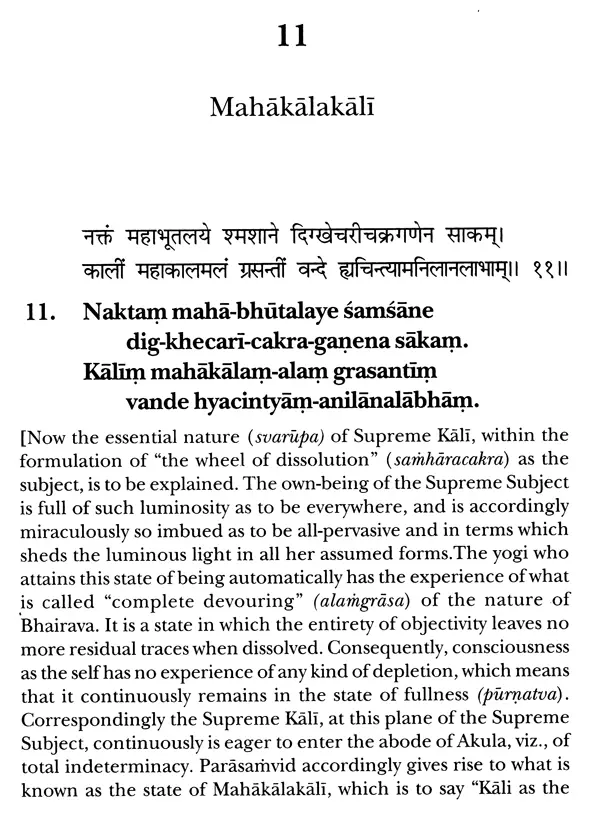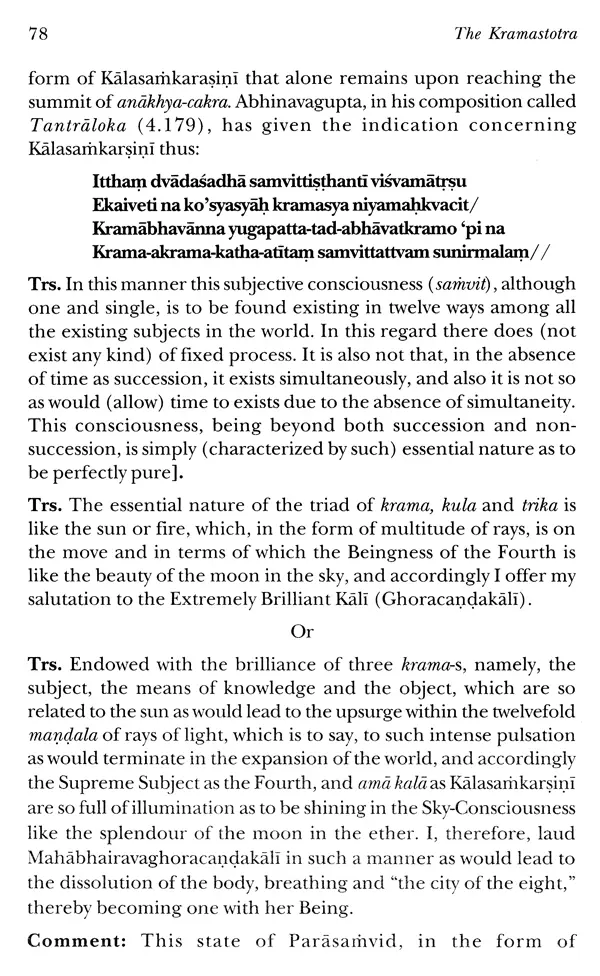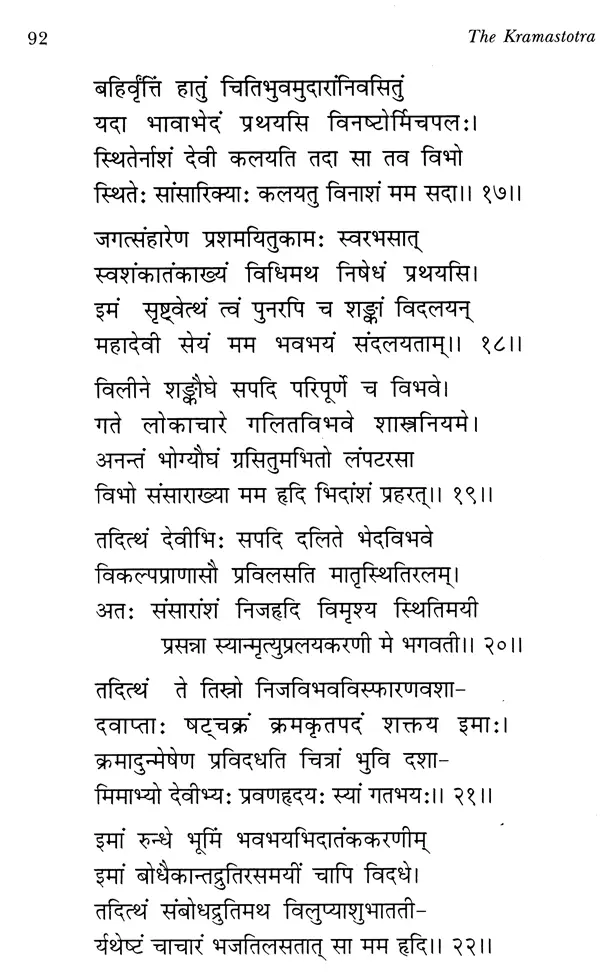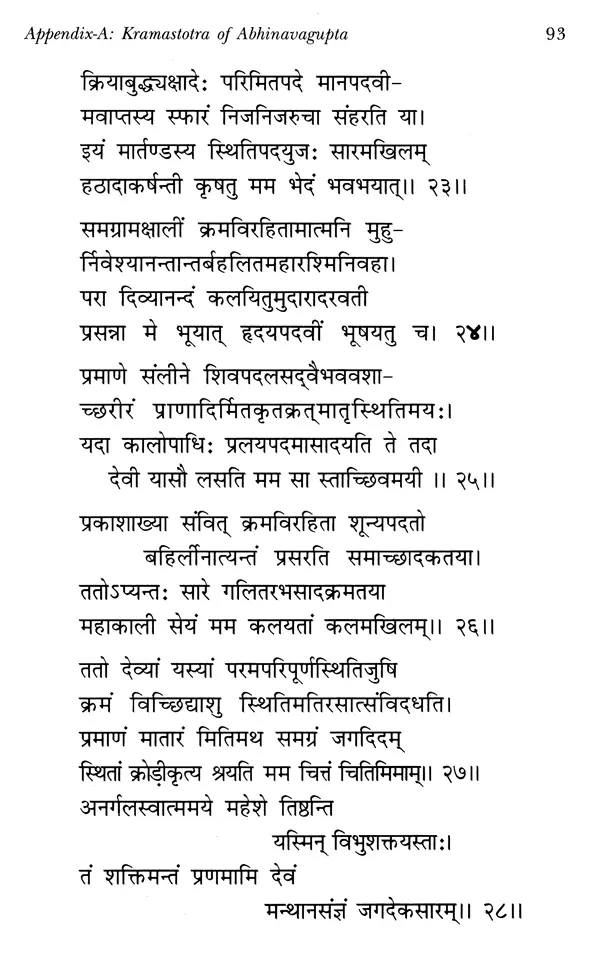
The Kramastotra of Siddhanatha Or The Hymn on Time as a Process
Book Specification
| Item Code: | UAZ831 |
| Author: | Moti Lal Pandit |
| Publisher: | MUNSHIRAM MANOHARLAL PUBLISHERS PVT LTD |
| Language: | English |
| Edition: | 2022 |
| ISBN: | 9788121513616 |
| Pages: | 130 |
| Cover: | HARDCOVER |
| Other Details | 9.00 X 6.00 inch |
| Weight | 290 gm |
Book Description
A new Saktic/Tantric spiritual lineage was established at the close of the 7th century AD in the valley of Kashmir by Sivanandanatha, which came be known as the Path of Kali (Kalinaya) or the Path of Succession (Kramanaya). It is said that Sivanandanatha was the head of a Tantric sub-center (upapilhadesa) known as the Uttarapitha, which also was referred to as the Medhapitha. Sivanandanatha is said to have imparted the esoteric knowledge of the Krama system to three female ascetic Yoginis, namely, Keyüravati, Madanika, and Kalyanika. These Yoginis revealed this fund of knowledge respectively to Govindraja, Cakrabhānu and Erakanatha. It is given such an epithet on account of the fact that the adept of this path is asked to visualize, while deeply involved in meditation, the powers of one's own consciousness/self, in the form of twelve Kalis, as engaged both in the process of emanation (spt) and absorption/dissolution (samhāra) of phenomena at the levels of the knowing subject (pramata), the means of knowing (pramana), and the knowable (prameya). This process of visualization of meditation has to be conducted in such a manner as would let the practitioner experience as if he himself is the Supreme Lord containing within himself the entire phenomena. The process of visualization is centered on the twelve aspects of Parasamvid in the form of twelve Kalis, and it has to be carried out in a regular order of succession (krama), viz, one aspect of Kali to be followed by another. On account of the meditative succession, the system is also known as Kramanaya or the Path of Succession.
Moti Lal Pandit, trained as a theologian and linguist, has been engaged in Indological research nearly for last fifty years. He has published books and articles on a vast range of subjects. Initially he began his research in Vedic religion and philosophy. Gradually he shifted his attention towards Buddhism, and, as a result of this shift, he has been successful in publishing a number of books on Buddhist philosophy and history. For last several years, however, he has been fully engaged in the study of the Trika Shaivism of Kashmir. Some of his publications are: Vedic Hinduism; Essentials of Buddhist Thought; Philosophy of the Upanishads; Samkara's Concept of Reality; Did Marx Kill God; Buddhism in Perspective; Being as Becoming: Towards Transcendence; Sunyata: The Essence of Mahayana Spirituality; Buddhism: A Religion of Salvation; Encounter with Buddhism; The Buddhist Theory of Knowledge and Reality; Transcendence and Negation; The Trika Shaivism of Kashmir, The Disclosure of Being; An Introduction to the Philosophy of Trika Shaivism; The Philosophical and Practical Aspects of Kashmir Shaivism; From Dualism to Non- Dualism; (trans.) The Essence of Supreme Reality, or The Paramarthasãa of Abhinavagupta.
Kali as the embodiment of the Mother Goddess is purely Tantric in origin. Tantricism uses the idea of the Goddess in such a manner as would lead to an easy description of the Ultimate. The notion of the Ultimate to a tantrika is not that of an impersonal Absolute, but of an Absolute that contains within itself the flow of such powers that give rise to cosmic activities of emanation, preservation, dissolution, anakhya and bhasa. It is the Goddess that is seen to be representing the powers of the Absolute. At the transcendental level, the Absolute is neither Siva nor Sakti; it is beyond such dichotomizing binaries. At the relative level of thought, however, we speak of the Absolute in terms of Śiva and Sakti, and Sakti being none else than Kāli.
It was Sivanandanatha who, for the first time, popularized the concept of Sakti as Kali in the valley of Kashmir during the close of the 7th century and the middle of the 8th century. He interpreted anew the Tantric concept of divine powers in terms of what has come to be known as Kalinaya or Kramanaya, meaning the Path of Kali or the Path of Succession. It is said that Sivanandanatha was the head of a Tantric sub-center (upapithādesa) known as the Uttarapitha. In the process of spread of Tantricism throughout the Indian subcontinent, there emerged four main Tantric centers at such places as Kamakhya-pitha in Assam, Purnagiri-pitha in Andhra, Jalandhara-pitha at Kängara, and Oddiyana-pitha at Jaganathapuri. In addition to these four main centers, there also emerged a number of sub-centers throughout the country, and one such sub-center also existed in Kashmir by the name of Medhapitha, which most probably is identical with the Uttarapitha, of which Sivanandanatha was the head.
The Krama system of thought or lineage that emerged at the close of 7th century AD in the valley of Kashmir is Saktic in its over-all orientation. Being Säktic in inclination, it is but natural for it to postulate the Mother Goddess, in the form of Kali, as the Ultimate metaphysical principle. As a Saktic school of thought, its relationship with other Trika lineages, such as Spanda, Pratyabhijña and Kaula, is of the same nature that occurs between the stem and the branches of a plant. The Krama, however, has doctrinally much in common with the other Säktic schools, namely, for example, with the Kaula school, as in both the schools "the cycle of twelve Kális" is given, conceptually and practically, a prominent place. The Krama, however, differs from the Kaula insofar as the utilization of the spiritual methods or means (upaya-s) is concerned. The Krama follows the "means of energy" (säktopaya), whereas the Kaula system, being highly influenced by the Pratyabhijñā, adheres to the practices enunciated by the "means of Sambhu" (Sambhavopaya). The Krama believes that the limited individual is spiritually so polluted or impure as would need to engage in such spiritual practices that would uplift him step by step, which is to say that it believes in a graduated spiritual progress. For the Krama the conceptual purification is a sine qua non for any kind of spiritual progress, and so follows the "means of energy" (säktopaya). The Kaula school, on the contrary, believes in a sudden or spontaneous emergence of divine awareness of I-consciousness, which is to say that the sadhaka has the experience of perfect identity with the Absolute, and accordingly adheres to the "means of Sambhu" (sambhavopaya).
Book's Contents and Sample Pages


